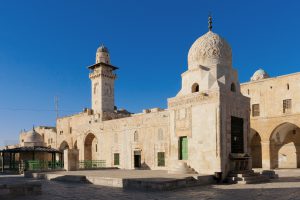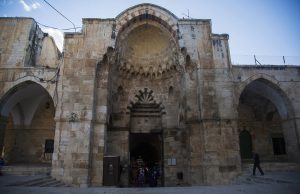Since its early days, al-Aqsa Mosque has embraced an active scientific movement such as teaching the Holy Quran, Hadith and Islamic Fiqh but this activity has taken a more organized dimension by the emergence of the term of the school as an educational institution that ensures continuity. There are many stories that indicate the spread of the schools in al-Aqsa, which demonstrates the status of al-Aqsa Mosque and its significant role in the dissemination and maintenance of the Islamic sciences.
The spread of the schools in al-Aqsa was correlated with the Ayyubid period. It also flourished during the Mamluk period. Moreover, the scientific movement maintained its activity during the Ottoman rule.
Until this time, these schools continue to spread throughout al-Aqsa Mosque, attesting to the Islamic interest in al-Aqsa and the understanding of its scientific role and significance. Some of these schools continue to function as educational institutions while others are used as offices or facilities for the mosque.
- Al-Khutniya School
The Khutniya School was built during Saladin’s reign in 587 AH/1191 AC adjacent to AlQibly Mosque’s southern wall and was named after Sheikh Al-Khutni, a scholar who taught Islamic Sciences at it. The school’s original structure was subject to several changes by adding some rooms and restrooms to it. Today, only a few arches and windows remain of the school’s original building.
- Al-Fakhriya School
Judge Fakhr Ad-Din Mohammad bin Fadl Allah built this school in 730 AH/1329-1330 AC. It was originally built as an Islamic religious school, but it was later turned into a Suf lodge. Israeli forces have demolished parts of the school, leaving only three rooms and a small mosque out of its original building. The school’s mosque structure is simple; it is an oblong room which is based on three stone pillars and topped with three magnificent domes that were added to the building during the Ottoman era. The mosque also has a beautiful niche built with red bricks pointing towards the Qibla.
- Al-Duwaidaryah School
Prince Alam Ad-Din Abu Musa Sanjar Al-Duwaidar built this school near the Gate of Darkness in 695 AH/1295 AC. In addition to being an Islamic school that taught the Shafe jurisprudence, it also served as a hospice. The school remained an educational address until the late Ottoman era. Remarkably, it was devoted to teaching girls. It continued with this function during the time of the British Mandate. The school is made of a two-story building that has a beautiful entrance decorated with stalactites*; it also has a mosque inside. Today, the building is used as a school called Al-Bakriyah School for people with special needs.
- Al-Tankaziyah School
The Governor of Great Syria Prince Saif Ad-Din Tankaz An-Nasri built this school in 729 AH/1328 AC. The school is located between the Gate of the Chain to the north and Al-Buraq Wall to the south. It was originally dedicated to teaching Prophet Mohammad’s (PBUH) traditions (Sunnah and Hadith); however, it was turned into a courthouse during the Mamluk Sultan Qaitbay’s reign. Under the Ottomans it became a Shari’a Court, until the early days of the British Mandate when the Grand Mufti of Jerusalem Amin Al-Husseini made it his place of residence. The building went back to being a school for teaching Islamic jurisprudence until it was confiscated by the Israeli Authorities in 1969 and turned into a Border Police Station to monitor and oversee Al-Aqsa Mosque.
- Al-Farisyah School
Al-Farisyah School is named after its founder Prince Faris Al-Baki bin AlAmir Qatlo bin Abdullah. The school was built in 755 AH/1352 AC, on top of Al-Aqsa Mosque’s northern corridor, where a staircase leads to its arched entrance. Inside the school there is an open courtyard and a staircase connecting to the adjacent Aminyah School, as the two schools’ structures overlap. Today, the school is used as a place of residence for a number of Jerusalemite families.
- Al-Ashrafyah School
Prince Hassan bin Tatr Ath-Thahiry built this school as a gift for King Ath-Thaher Khashqoum in 872 AH/1426 AC. However, the latter died before the construction was completed; thus, Prince AthThahiry decided to dedicate it to Sultan Al-Ashraf Qaitbay who assigned scholars and teachers to it. When Sultan Qaitbay came to Jerusalem he visited the school, but was not quite impressed by the building, so he demolished it and ordered its reconstruction in 885 AH/1470 AC. Al-Ashrafyah School is considered to be the third architectural jewel of Al-Aqsa Mosque beside Al-Qibly Mosque and the Dome of the Rock. Half of the school is located inside Al-Aqsa, while the other half is outside the Mosque’s borders. The school consists of a two-story building and has a beautiful entrance decorated with white and red bricks. It also has a mosque that was once used by the followers of the Hanbali principle. There are two graves inside its mosque; one of them is thought to be Sheikh Al-Khalil’si tomb.Today, a significant part of the school is used as Al-Aqsa Shar’ia School for Girls; another part is used as an office for the Department of Manuscripts subordinate to the Islamic Waqf Directorate, while the remaining parts are used as houses where some Jerusalemite families live. In 2000, the Islamic Waqf Department and the Welfare Association carried out a comprehensive renovation of the building.
- Al-Malakiyah School
King Joukndar Al-Malaki AnNasiri built this school in 741 AH/1340 AC during the reign of Sultan An-Naser Mohammad bin Qalawun. The school consists of a two-story building and has a beautiful decorated entrance, which leads to a vestibule (a small room or hall between an entrance and the interior of the building or house) connected to a central open courtyard; its largest room overlooks Al-Aqsa Mosque’s courtyards. This school is currently used as residence for some Jerusalemite families.
- Al-Jawiliyah School
Alm Ad-Din Sanjr bin Abdullah Al-Jawli, Governor of Jerusalem during King An-Naser bin Qalawun’S reign, built this school in 712- 720 AH/1312-1320 AC, on the northwestern side of Al-Aqsa. The school is made of a two-story building that has an open courtyard surrounded by a number of rooms; its southern façade overlooks Al-Aqsa Mosque’s courtyards. The school was turned into a city hall in the 9th Century AH, when the Ottomans took over Jerusalem, and later became a government’s house but returned to being a city hall once again after a while. Today, it is used as part of AlOmariyah School.
- Al-Khatuniyah School
Lady Agl Khatun endowed this school in the 7th Century AH. Its eastern windows overlook Al-Aqsa Mosque’s courtyard. Originally it was dedicated to teaching Qur’an and Islamic jurisprudence. Several Islamic and national fgures are buried inside this school such as: Prince Mohammad Ali Al-Hindi, an Indian Prince who defended the Palestinian cause; Musa Kathem Al-Husseini, head of the Nationalist Executive Committee of the Palestine Arab Congress and Mayor of Jerusalem under the Ottomans; Sharif Abdul Hamid bin Awn, father-in-law of King Abdullah of Jordan; Ahmad Hilmi Abdel Baqi, frst Palestinian Prime Minister under the 1948 All-Palestine Government; Abdul Qader Al-Husseini, grandson of Musa Kathem Al-Husseini, commander of local Arab forces during the 1948 War and leader of the famous Al-Qastal battle; his son Faisal Al-Husseini, a Palestinian politician and head of the Palestinian representation in Jerusalem (Orient House); and Abdul Hamid Shoman, founder of the Arab Bank.
- Al-Asa’rdiyah School
Majd Ad-Din Abdul Ghani bin Saif Ad-Din Abu Bakr Yusuf Al-Asa’rdi ordered building this school in 760 AH/1385 AC, but it was officially endowed in 770 AH/1369 AC. The school’s entrance is located in Al-Aqsa’s northern corridor; it consists of a two-story building and an open courtyard. The school is topped with three beautiful domes and has a mosque that overlooks Al-Aqsa’s courtyard. Today, the building is used as a house.
- Al-Araguniyah School
Prince Aragun Al-Kamili started building this school in 758 AH/1356 AC, but he died before its construction was completed. Consequently, the mission was carried on by Rokn AdDin Baibars. The school is located between the Cotton Merchants Gate and the Iron Gate at the west end of Al-Aqsa Mosque. It consists of a two-story building and has a beautiful entrance decorated with red and white bricks that can be found in the southern part of the Iron Gate alley. The entrance has a plate with the school’s founder’s name and the year of its construction inscribed on top of it. It also has two tombs inside; one belongs to its founder Prince Aragun, while the other is for the Hashemite King AlHussein bin Ali who was buried inside the school’s eastern room on the first floor. Today, the school is used as a house.
12. Al-Aminiyah School
Amin Ad-Din Abdullah built this school in 730 AH/1330 AC, overlooking Al-Aqsa Mosque’s northern corridor. The school consists of a two-story building, where a number of Muslim scholars were buried. Its structure overlaps with AlFarisyah School. Today the school building is used as a house.
13.Al-Basitiyah School
Al-Basitiyah School is located in the north of Al-Aqsa Mosque, to the east of the Gate of Darkness next to AlDuawaidaryah School. It was endowed by Judge Zein Ad-Din Abdul-Basit Khalil Al-Dimashqi/AlQahiri who was in charge of the treasury and army during the reign of King Al-Mu’ayyad Saif Ad-Din Sheikh Al-Mamluki (815-824 AH/1412- 1421 AC). The school’s foundation is credited to Sheikh Al-Islam Shams AdDin Mohammad Al-Harawi, inspector of the two noble mosques (Al-Aqsa and Al-Ibrahimi) who commenced its construction but passed away before its completion. It consists of three rooms and an outdoor yard. The school was concerned with teaching Shafei jurisprudence, Hadith and the Holy Qur’an for orphans, especially the Sufis. Today, it serves as a residential building.
- Al-Manjakiyah School
This school is located on the Western Wall of Al-Aqsa Mosque to the left when entering the mosque from the Inspector’s Gate. It is attributed to its founder and the registrar of its waqf in the 8th Century AH, Saif Ad-Din Manjak Al-Yousif An-Nasiry. It comprises two floors which have a large covered corridor and include many rooms and halls of different sizes. Initially, it was built as a school, then, towards the end of the Ottoman era, it was turned into a residential house. It also served as a shelter for strangers who visited Jerusalem. During the British Mandate it became an elementary school. Later, the Supreme Islamic Council renovated it to become its headquarters. However, today it serves as the headquarters of the Jerusalem Waqf Directorate which is subordinate to the Jordanian Ministry of Endowment and Islamic Affairs.
- The Ottoman School
The Ottoman School is located at the Ablution Gate, next to AlAshrafyah School. It is named after a Turkish lady, called Asfahan Shah Khatun Bint Mahmoud Al-’Uthmaniyah, who established it in 840 AH/1436 CE. The school consists of two floors and can be reached through a beautiful Mamluk entrance surmounted by inscription of its foundation and decorated with alternating red and white stones. The school consists of a number of rooms and a small open courtyard, overlooking Al-Aqsa Mosque, with a façade made of red and white stones. There are two tombs to the left side of the entrance; one of them is for the lady who endowed it. The building was reconstructed by the Supreme Islamic Council, yet the school and its mosque sustained some damages because of the Israeli authorities’ excavations beneath it. The Israeli authorities have confiscated the school’s mosque allegedly to create ventilation for the tunnel beneath it.


